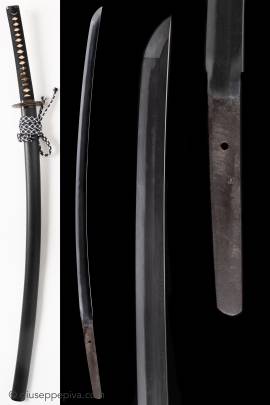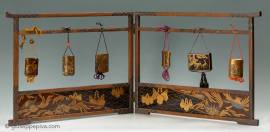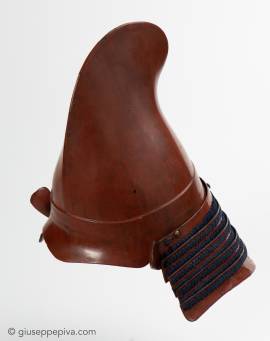Mumei, Osafune KiyomitsuLate Muromachi Period (1392-1573), circa 1560NBTHK Hozon Tōken-Nagasa [length]: 74.3 cmSori [curvature]: 2.4 cmMotohaba [bottom width]: 3 cmSakihaba [top width]: 2 cmMotokasane [bottom thickness]: 7 mm-Sugata [configuration]: Shinogi-zukuri, iori-mune, elongated chu-kissakiKitae [forging pattern]: Mokume hada with jinie.Hamon [tempering pattern]: Gunome midare and ko-choji midare in nie-deki on the omote side; ko-notare and gunome midare on the ura side. Ashi, yō, sunagashi and kinsuji.Boshi [point]: Notarekomi with hakikake kaen.Nakago [tang]: O-suriage,...
WORKS FOR SALE
InrokakeFolding inro display standMid Edo Period (1615-1867)109 cm x 40 cm A lacquer-decorated inro display stand (inro-kake) with the hangers shaped as butterflies. The decoration is a revival of a typical pattern from Momoyama period: a zigzag line across the surface divides the decorative fields in two; on one side the design represents paulownia flowers and pampas grass, while the other is decorated with shells and seaweeds. The two terminals are slightly flared recalling the shape of the torii, traditional gate in the shinto shrine, and are decorated with a...
Iron finished in red lacquerEdo period, 17th century Among the kawari kabuto that reproduce shapes of headgears, the eboshi was a favorite by samurai since ancient times. In fact, helmets in the form of this court cap were very popular already in the Sengoku period. The simplicity of realization was certainly a determining factor for the spread of this kabuto, but a big credit goes to the effectiveness that this form meets in the protection against firearms, being particularly suitable to deflect the bullets of the matchlocks that at that time were introduced in Japan by the Portuguese....
Copyright © 2016 - giuseppe piva - VAT: 05104180962










